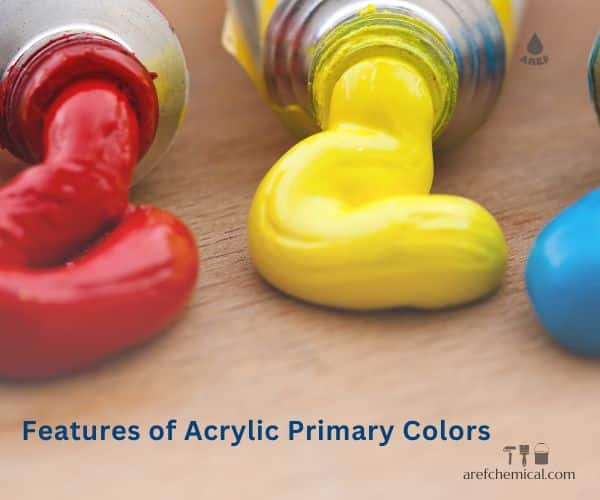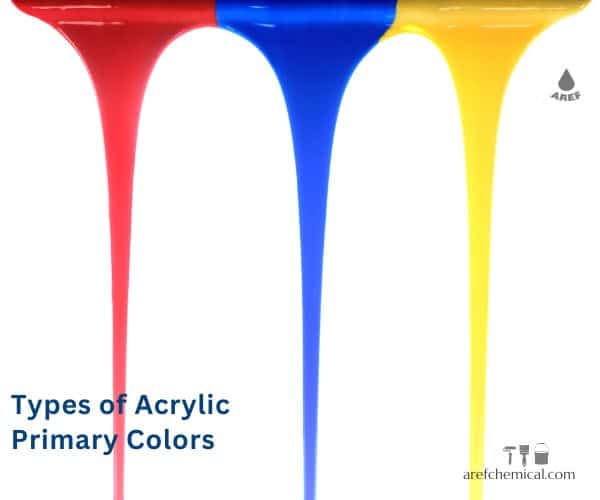Acrylic primary color is known as one of the important raw materials in the paint and painting industry. This color is a type of water-based paint that is used to create works of art, interior design, and industrial paint production. When we talk about the “acrylic primary colors”, we mean the original acrylic paint. Acrylic paint is not only one of the most popular art paints, but also the mother of all acrylic paints. This main color with its unique characteristics has played a very important role in the development and expansion of contemporary art. In this article, we will review the features, uses and benefits of acrylic primary colors.
History of acrylic primary colors
Acrylic paint was first produced in the 1930s by DuPont in America. These paints, which were made with acrylic bases, had unique and distinct characteristics compared to oil paints. The increasing popularity of these colors in the following decades, especially in the modern and postmodern art movements, highlighted its key role in the evolution of contemporary art.
Unique features of acrylic primary colors
This product has unique and distinct features compared to other colors. including:
- High drying speed: Original acrylic paint dries much faster compared to oil paints. This allows artists to create multiple layers within an artwork.
- Diversity in creating textures: Acrylic paint can create different textures, including thick, thin, porous and embossed. This feature helps artists to have diverse and creative visual expression.
- 3. The possibility of unlimited mixing: the mother of acrylic paint is easily mixed with other acrylic paints and allows the creation of a wide range of colors.
- Soluble in water: One of the distinctive features of acrylic primary colors is its solubility in water. This feature makes working with this material easier and reduces the need for chemical solvents.
- Stability and durability: These colors are resistant to light and water, and this feature makes the works of art more permanent.
- Color variety: Acrylic primary color is available in a wide range of colors and shades, which allows artists and painters to be more creative in creating their works.
Reasons for using acrylic primary colors
In this section, we discuss the reasons for using this product a lot.
- One hundred percent acrylic latex
- Washable
- Speed of work and impressive coverage
- Anti-mold
- Anti-algae
- Resistant to water and weather conditions
- No harmful environmental effects
- Shock and stain resistant technology
- Easy to use
- Excellent durability and adhesion
- Resistant to water and weather conditions
The importance of original acrylic paint in art history
Acrylic paint has played a key role in the evolution of contemporary art. This color has given artists the possibility to perform creative and diverse works that are tangible in different artistic movements such as abstract expressionism, pop art and abstract painting. The original acrylic paint or “acrylic primary colors ” has played an irreplaceable role in the history and evolution of contemporary art due to its special characteristics such as high drying speed, the possibility of creating various textures and unlimited mixing capabilities. This color has provided artists with the possibility of creative and diverse visual expression and has had a strong presence in various artistic movements.
Applications of acrylic primary colors
This product is used in various cases such as visual arts, interior design, industry, etc.
- Visual arts: painters use acrylic base color to create artistic paintings. Due to its unique properties, this color allows them to experiment with different techniques.
- Interior design: acrylic base paint is used to paint walls, furniture and other interior elements. These colors are a suitable choice for improving the beauty of spaces due to their stability and variety in color.
- Industry: In various industries, acrylic base color is used to produce industrial colors. These colors are used to paint various devices and equipment.
- Art education: In schools and art centers, acrylic paint is used as one of the primary educational materials. The ability to dissolve in water and the ease of working with it make this material suitable for learning art.
What surfaces is acrylic paint used for?
- Plaster surfaces
- Brick surfaces
- Cement surfaces
Types of acrylic primary colors
Acrylic paints are divided into different types, each of which has its own characteristics and uses. Some types of acrylic primary colors are:
- Matte acrylic primary colors: This type of paint has a matte surface and is usually used for walls and interior surfaces.
- Shiny acrylic primary colors: This type of paint has a shiny surface and is suitable for surfaces that need a beautiful effect due to its light reflection property.
- Semi-Gloss Acrylic primary colors: This type has a combination of matte and glossy properties and is usually used on surfaces that want a balance between aesthetics and functionality.
- Waterproof acrylic primary colors: This type of paint has waterproof properties and is usually used in wet environments such as bathrooms and kitchens.
- Washable acrylic primary colors: Fortunately, this type of paint is very easy to clean and is usually more suitable for places that are prone to dirt.
- Acrylic primary colors with acrylic base: This type of paint has special features such as high adhesion, fast drying speed and UV resistance.
- Primary colors of acrylic paint for outdoor space: This type of paint is designed for outdoor use and usually has a high resistance to atmospheric factors such as rain and sun.
The use of each of these types depends on the type and condition of the surface to be painted.
Teaching how to apply color
First, stir the acrylic paint well and make sure it is uniform. To apply the paint, use a high quality roller, polyester brush or airless spray. Paint the ceilings first and then move on to the walls. When using the roller, move from the wet area to the dry area. For surfaces that have putty, give the paint more time to dry before applying the next coat. On some dark or light colors, you may need to apply an additional coat or two for full coverage. Also, the weather conditions and the execution method you choose will affect the final quality of the work.
Teaching how to prepare paint
When sanding wood, walls or removing old paint from desired surfaces, dust is scattered that may contain lead particles. Breathing these particles can lead to numbness and serious brain damage, especially in children and pregnant women. Therefore, it is necessary to observe safety in order to avoid possible risks.
To control the dust created, the use of wet wipes or a vacuum cleaner is recommended as one of the best prevention methods. Also, the use of masks and safety glasses is mandatory for people who are working.
Teaching paint preparation for surfaces
The mother of water-based acrylic paint is based on acrylic resins and must be diluted with water to use. In most cases, building painting requires the use of a specific color range of acrylic paint, which is not available in the market and needs to be made manually. By using the acrylic primary colors, you can combine different colors and achieve the color shade you want. Also, this color alone is also used for coloring.
Freshly dried wall and plaster:
Fill the cracks and holes with putty and let it dry completely. Then, smooth the surface using sandpaper. Clean the resulting dust and cover the surface first with primer or acrylic primary colors. After this layer dries, apply 2 to 3 layers of acrylic paint as the final layer.
Wood:
Fill cracks and holes using wood putty. After the putty is completely dry and set, smooth the surface with wood sandpaper. After that, clean the remaining dust and continue your work using the acrylic primary colors.
Metal:
Clean the surface of any rust and then apply a metal primer. After that, cover the surface with acrylic paint mother.
Plaster:
For plaster surfaces, first apply a primer for plaster and then apply 2 to 3 layers of acrylic paint.
raw wood:
First apply the special primer for wood, then apply 2 to 3 layers of acrylic paint.
brick:
First, apply a special primer for bricks, then apply 2 or 3 layers of acrylic paint.
Cement:
First, apply the special primer for cement, then apply 2 to 3 layers of acrylic paint.
conclusion
Acrylic primary colors has a special place in the world of art and industry due to its many features and applications. From visual arts to interior design and industrial production, this color is widely used. Due to its high durability and stability, it is expected that the use of acrylic primary colors will expand in the future. By choosing this special color, artists or designers can depict their creativity and ideas and create unique works.







20 Responses
Great Reasons for using acrylic primary colors
Clean the resulting dust and cover the surface first with primer or acrylic primary colors.
First, stir the acrylic paint well and make sure it is uniform
thank you for History of acrylic primary colors
This type of paint is designed for outdoor use and usually has a high resistance to atmospheric factors such as rain and sun.
Matte acrylic primary colors, This type of paint has a matte surface and is usually used for walls and interior surfaces.
Chemical solvents can effectively dissolve wood glue but should be used cautiously to avoid undesirable reactions.
https://arefchemical.ir/%da%86%da%af%d9%88%d9%86%d9%87-%da%86%d8%b3%d8%a8-%da%86%d9%88%d8%a8-%d8%ae%d8%b4%da%a9-%d8%b4%d8%af%d9%87-%d8%b1%d8%a7-%d9%be%d8%a7%da%a9-%da%a9%d9%86%db%8c%d9%85/
Ensure that you have good ventilation if you’re painting indoors. Ideally, work in moderate temperature and humidity conditions to help the paint adhere properly.
Move furniture, decorations, and any other items that could get damaged or dirty during the painting process.
Use drop cloths or plastic sheeting to protect floors and any remaining furniture from spills or splatters.
For plaster surfaces, start by applying a primer specifically designed for plaster, then follow with 2 to 3 layers of acrylic paint.
Acrylic primary colors offer several unique features that make them popular among artists and crafters.
Acrylic primary colors are known for their intense pigmentation. They can produce bright and vivid tints and shades, making them highly effective for creative applications.
One of the defining features of acrylic paints is their fast-drying nature. This allows artists to work quickly and layer colors without long waiting periods, facilitating dynamic painting techniques.
Acrylic paints can be easily thinned and cleaned up with water when wet, making the painting process more manageable compared to oil paints.
Acrylic paints are highly versatile and come in primary colors that are fundamental for mixing and creating a wide spectrum of hues. Here’s a breakdown of the primary colors used in acrylic painting.
Characteristics: A vibrant, opaque red that is lightfast and has excellent coverage. It can lean towards warmer or cooler tones depending on the specific shade.
Uses: Great for creating vivid highlights and warm tones. Often used in portraits, landscapes, and abstract work.
Uses: Ideal for landscapes, skies, and water. It’s also used to create greens when mixed with yellows.
Uses: Commonly used for highlights and as a base color in floral paintings and sunny scenes. It mixes well with reds and blues.